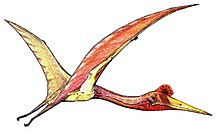Short-tailed pterosaur
| Short-tailed pterosaur | ||||||||||||
|---|---|---|---|---|---|---|---|---|---|---|---|---|

Skeletal reconstruction of Pteranodon |
||||||||||||
| Temporal occurrence | ||||||||||||
| Hettangian ( Lower Jurassic ) to Maastrichtian ( Upper Cretaceous ) | ||||||||||||
| 199.6 to 65.5 million years | ||||||||||||
| Locations | ||||||||||||
|
||||||||||||
| Systematics | ||||||||||||
|
||||||||||||
| Scientific name | ||||||||||||
| Pterodactyloidea | ||||||||||||
| Plieninger , 1901 |
The pterodactyloidea (Pterodactyloidea) are a group ( taxon ) of the Flugsaurier (Pterosauria).
The fossil record of this large clade of pterosaurs begins in the early Lower Jurassic ( Hettangian ) and extends to the end of the Mesozoic era on the Cretaceous-Tertiary border (199.6 to 65.5 mya ). The short-tailed pterosaurs included the largest airborne creatures in the history of the earth. Its largest representative was Quetzalcoatlus from the late Upper Cretaceous Texas, which reached a wingspan of at least 12 meters. The phylogenetically oldest and also one of the smallest members of this group was Pterodactylus from the Central European Oberjura with a span of 50 to 75 centimeters. This genus, which was first found in the Bavarian Solnhofen limestone , gave the entire group its name.
features

Their general blueprint was very similar to that of the long-tailed pterosaurs ("Rhamphorhynchoidea"), but they had a greatly shortened tail, which had probably lost its importance for flight, and an elongated neck and head. In addition, their metacarpal bones were elongated, making them more upright, quadruped , propping themselves up with all four limbs.
Systematics
The short-tailed pterosaurs are divided into four taxa, which were classified as superfamilies in the classical, rank-based system. It is the ornithocheiroidea , to which especially large glider pilots such as Pteranodon belong, and who fly over the seas like today's albatrosses and frigate birds feed on fish. Other groups are the Ctenochasmatoidea , which had a trap bite and probably waded looking for their food in shallow areas of rivers and lakes, the Dsungaripteroidea , which developed a scissor bite in order to be able to eat hard-shelled food such as mussels or other molluscs , and finally the Azhdarchoidea , theirs early forms were fish-eaters, the later ones inhabited more terrestrial biotopes and probably often stayed on the ground, hunting like gigantic storks or feeding on carrion like marabouos .


The family relationships are illustrated by the following cladogram :
| Pterosaurs |
|
|||||||||||||||||||||||||||||||||||||||
|
|
literature
- David M. Unwin: The Pterosaurs. From deep time. PI Press, New York NY 2006, ISBN 0-13-146308-X .
Initial description
- Felix Plieninger: Contributions to the knowledge of the pterosaurs. In: Palaeontographica. Vol. 48, Delivery 2/3, 1901, ZDB -ID 207560-x , pp. 65-90, digitized .
Web links
Individual evidence
- ^ The Paleobiology Database. Last accessed December 2, 2009
- ↑ Junchang Lü, David M. Unwin, Xingsheng Jin, Yongqing Liu, Qiang Ji: Evidence for modular evolution in a long-tailed pterosaur with a pterodactyloid skull. In: Proceedings of the Royal Society. Series B: Biological Sciences. Vol. 277, No. 1680, 2010, ISSN 0080-4649 , pp. 383-389, doi : 10.1098 / rspb.2009.1603 .